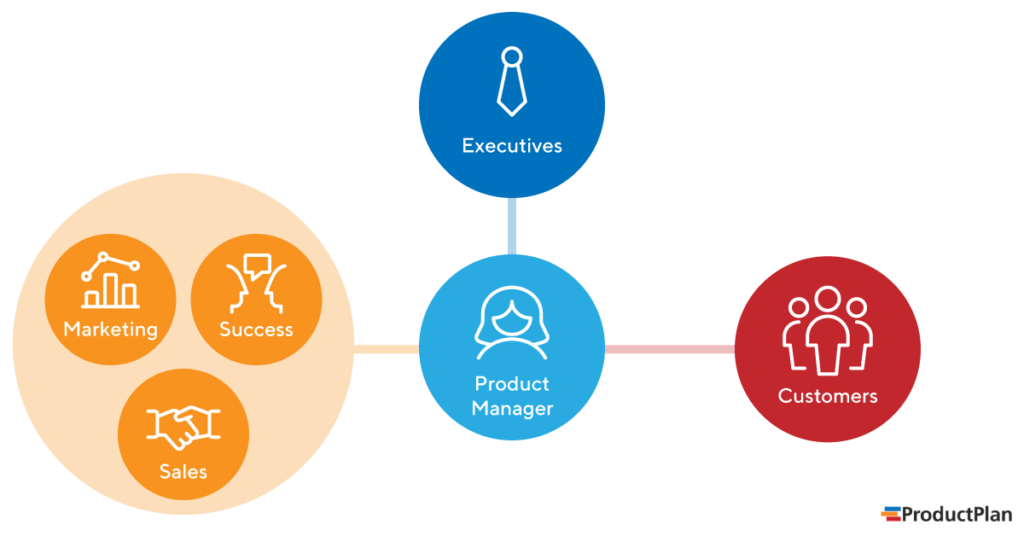Communication is a critical skill for any job, but it’s particularly crucial for product managers. When we surveyed thousands of them, half said it was the most important skill they use daily.
But not all communication is created equal. Just like how we interact differently with our friends, parents, and coworkers, whomever we’re communicating with makes a big difference in how we do it. They care about different things and have varying expectations.
Start with Value
Before diving into optimizing our dealings with various audiences, let’s unpack our motivations. As product managers (PM), our focus is on our customers. We want to give them what they want, what they need, and what they’ll appreciate. If we keep these truths at the forefront of our thinking, it can power our communication with an unassailable purpose.
In our webinar, Laura Fletcher, Senior Product Management at Pivotal, describes why this is so important:
“Creating user value is at the heart of what we do as PMs, so it also needs to be at the heart of communication. What we need to care about as PMs is the why behind what we’re doing,” says Laura Fletcher, Senior Product Manager at Pivotal. “If you ask why enough times, in the work that you’re doing right now, hopefully, you’re going to get down to the answer of ‘it’s providing value to my users.’”
Watch the full webinar here:
As we communicate with others, we must ask ourselves, whom are we talking to? What do we need from them to continue or increase the value we’re delivering? We’ll have to navigate different personalities and internal politics along the way.
Three Streams of Communication

No two interactions are the same, and each interpersonal dynamic is slightly different. But the majority of our professional communications fall into three categories: horizontal, vertical, and external. Let’s explore each of the three product manager communication streams, examining why they’re different, and how to optimize your delivery for each.
1. Horizontal communication streams
For product managers, this communication stream is likely the one you employ most often. We spend most of our time communicating across the organization with cross-functional team members.
These are your fellow product team members and other internal teams. They care about execution. They want to know what they need to do and why they need to do it.
These teams are involved in implementation and execution, so they’ll need some of the nitty-gritty details you might leave out in other situations. Don’t hold back information because you think it isn’t relevant. The more context they have, the better work they’ll produce. A roadmap tailored roadmap for non-product teams must be easily digestible for those not immersed in the product strategy.
They also need an adequate level of detail so they can put themselves in the customer’s shoes. They must empathize with the customer to build something that not only works but works for those specific users.
Finally, these folks want to know what they’re doing really that matters. Product management represents the customer to the rest of the organization. You’re ensuring they build products that both satisfy and delight them while advancing the corporate goals and vision.
In a nutshell, you’re explaining to everyone why they should bother showing up to work every day (other than to collect a paycheck). Connecting the work to be done with the benefits it will provide to customers is critical. Even better is offering up any specific examples or anecdotes from key customers.
2. Vertical streams of communication
As a product manager, you reside in unusual strata within the organization. You’re likely not an executive, so you’ve got to manage up to that team (and the investors and board members above them). Likewise, you have an elevated role (in terms of its strategic importance and your exposure to more sensitive information) compared to many others in the organization. This position requires communicating down to stakeholders.
For those above you, they have a lot more on their minds than your product. They worry about a wide range of topics, including corporate finances and revenues, strategic partnerships, media and analyst coverage, and shareholders and investors getting their returns.
Your product is key to many of those areas. But the executive team is primarily concerned with the aspects directly impacting their own goals and responsibilities. They might care about a feature, but only because a competitor already has it or a significant customer asked about it. They’re tracking some of the same KPIs and metrics, but they’re not going to take a deep dive into what’s driving them.
With so much on their plate, they want to receive information as efficiently as possible. You’re the voice of the customer, but your job isn’t just to repeat everything you’ve ever heard. It’s to distill down what matters and offer it up in quick, digestible bites.
Creating and communicating your roadmap to executives should be careful to manage expectations. Setting expectations is also the case for roadmaps intended for board members and investors.
Things resonate when they have tangible meaning to these individuals. It must always tie back to something they can understand and care about, such as revenue. Why are you building it, and how does it link back to KPIs? Is it aligned with business goals, and will it advance them?
Of course, sometimes you’ve got to deliver bad news. Things have slipped, exceeded budgets, or angered customers. Usage is down; churn is up, adoption has stalled. No one wants to be the messenger for these updates, especially to the higher-ups.
Be honest and provide as much context as you can to frame it in a positive light (if there is one). But it’s also your job to sound the alarms and make everyone aware if things are genuinely going sideways.
3. External communication streams
Finally, you’ll also have plenty of occasions where you must communicate outward from the company. We’re talking about interacting with customers, potential users, and partners, plus media and analysts.
Their concerns are different from the previous two cohorts. They don’t care about why things are built or how it gets done. Their primary interest is in what’s in the works and when they can get their hands on it.
Projecting a robust and engaging vision is critical to this audience. Instead of throwing out a laundry list of features that won’t excite anyone, paint a cohesive and compelling picture that leaves them in an excited state of anticipation.
These conversations should clue them into the journey your product is on. It should convey the direction of the product, its key milestones, and place a heavy emphasis on benefits to the users (and not much else).
A customer-facing roadmap may be the method to communicate this information. But customer-facing roadmaps also come with their own set of caveats and should skip dates and implementation details in favor of broader themes.
Avoid stepping into the trap of delving into the details and doling out the specifics. Sure, they want them, but offering up these particulars only sets you up for disappointment when things get delayed or dropped.
Meanwhile, this communication stream should be a two-way street. There should be easy and convenient methods for them to tell you what they want to see, what troubles they’re having and which features might improve their experience.
Of course, they won’t all be actionable. But there should be a clear feedback loop in place to let them know their input is appreciated. It should also alert them if and when their ask becomes a reality.

Becoming a Great Communicator
Knowing your audience is key to effective communication. When you understand who you’re dealing with, you can speak their language. You can appropriately tailor your message and tap into what matters most to them.
After framing conversations in a meaningful context, it’s far easier to engage them both intellectually and emotionally. When your goal is alignment and shared understanding, it’s all about meeting them where they are. Or maybe you’re trying to motivate and inspire them with a glorious vision of future success.

In response, they’ll want to be heard. So listen. Even if you never act on any of it, you’ll know what they’re thinking and care about. You’ll also get a preview of the objections you may encounter along the way.
And of course, you can bring it all home with roadmaps. They capture the vision, the objectives, the plans, and the outcomes all in one place. And they provide a reference point before, during, and after the actual conversation occurs. 



